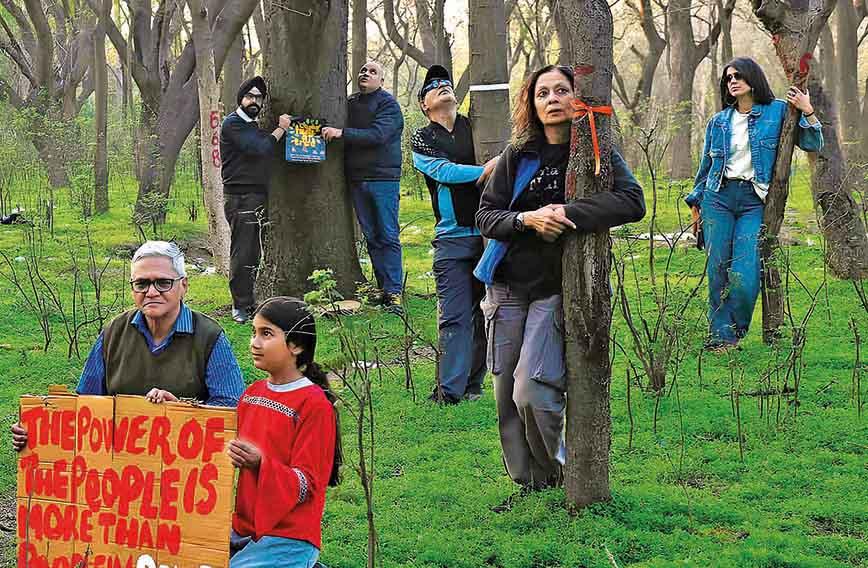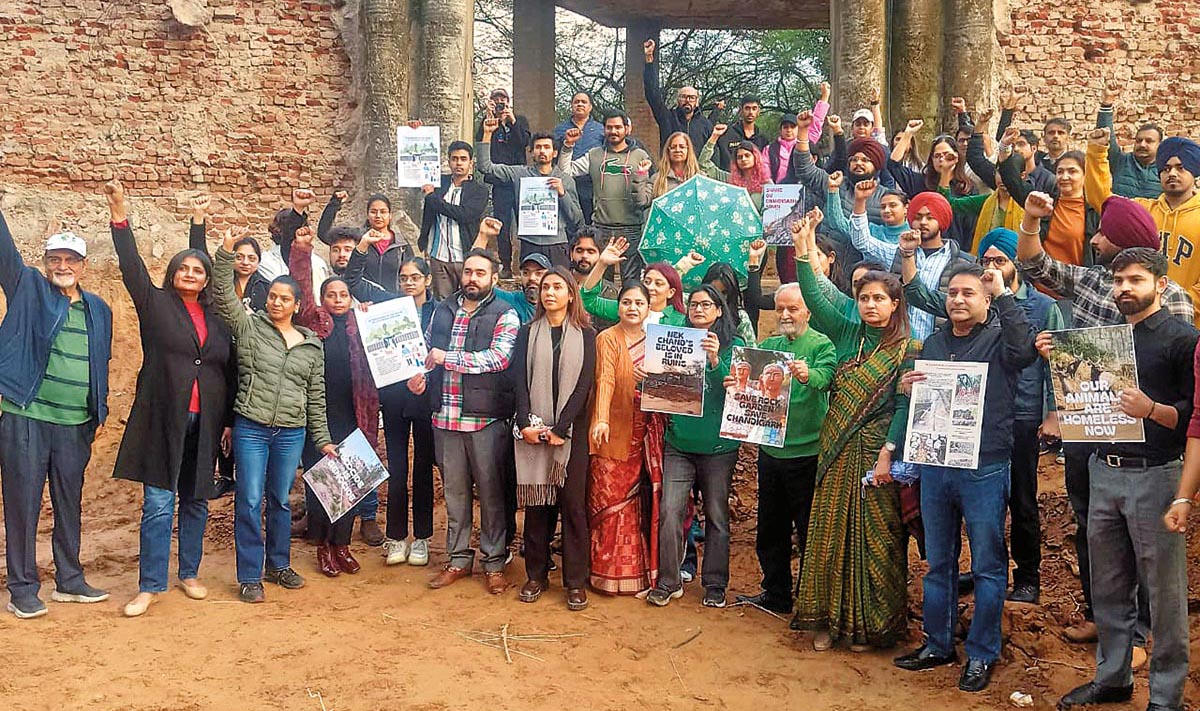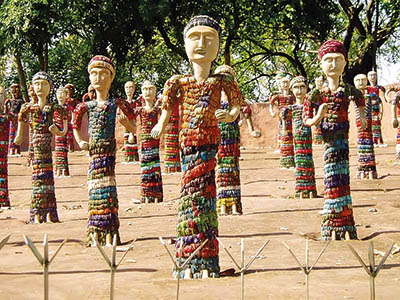
In Nek Chand’s memory, rallies and a Chandigarh Chipko
Raj Machhan, Chandigarh
CHANDIGARH’s iconic Rock Garden is in the eye of a storm after the Union Territory (UT) administration demolished a part of its outer wall. In its place, it plans to build a mundane parking lot and a wider road near the Punjab and Haryana High Court complex to ease the traffic woes of those who drive to work there.
The Rock Garden is a landmark of the city, and a major tourist attraction. Spread across 40 acres, it contains over 2,000 wondrous sculptures made of scrap and waste materials including bangles, glass, tiles, ceramic pots, broken pipes and more. It has interlinked pathways, made with scrap, and it is dotted with waterfalls and sitting spaces.
The garden was created by Nek Chand, a government employee, who started work on it in his spare time in 1957. Nek Chand created his garden secretly, till it was discovered and officially recognized by the authorities in 1976. In 1988, the government honoured him with the Padma Shri.
The destruction of the wall has angered citizens, heritage conservationists, environmental activists and the arts community. Nek Chand’s family is shocked and hurt by the administration’s unilateral action.
 |
|
Nek Chand’s granddaughter, Priyanka Saini |
“The Rock Garden isn’t just a tourist attraction, it is part of our identity. Every single soul in Chandigarh has spent their childhood hiding behind these walls, running through its pathways, climbing the very stones that are now being broken apart,” Priyanka Saini, Nek Chand’s granddaughter, told Civil Society.
“For many of us, the Rock Garden was our adventure park before we even knew what that meant. We have all read the story of Nek Chand in our history books, and parents tell their children the story of how one man built all of this. Each person felt pride in knowing that this magical place belonged to their city.”
Saini, in fact, even wrote to the Prime Minister pointing out that the garden attracts over 1.5 million visitors annually, second only to the Taj Mahal. It generates a profit of `2 crore to `3 crore. Destroying Nek Chand’s work is a “disservice to India’s legacy of innovation and environmental consciousness,” she wrote.
Citizens led a series of protests at the Rock Garden, including a Chipko-style demonstration. “It is a direct attack on our heritage and strikes at the root of our artistic values. If a part of the Rock Garden can be demolished then nothing remains sacrosanct,” says Samita Kaur, an environment activist and representative of the Saving Chandigarh Citizens Group.
The UT administration, which is carrying out the road widening and parking project, says that the work is being done according to directions given by the Punjab and Haryana High Court to decongest traffic leading to the High Court complex. The court gets a daily traffic load of around 3,000 to 4,000 vehicles. The existing infrastructure was found inadequate to handle vehicle flow and parking.
The demolition work began on February 22 when heavy machinery mowed down a part of the outer wall in the dead of night. Chandigarh residents woke up to shocking images of the demolished structure on social media the next day. “It was unthinkable. No one was informed about it. No permission had been taken from the Chandigarh Heritage Committee and other stakeholders. We were totally shocked,” says Samita.
Along with parts of the outer wall, the administration axed 200 trees for road widening. R.K. Garg of the Saving Chandigarh group says, “It is a unilateral action by the authorities. The Rock Garden is an integral part of the social and cultural fabric of the city. The demolition of the wall and adjoining structures is like mowing down a wall of the Red Fort to make way for widening a road.”
 Chandigarh residents hold placards
Chandigarh residents hold placards
The UT engineering department had floated tenders for the road widening and parking project much before they received approval from the Ministry of Environment and Forests. The tenders were awarded on December 24, 2024, while the ministry gave approval for conversion of forest land only on January 16 this year. “The administration should lay the entire facts before the public,” says Garg.
In response, the UT administration says that the outer wall was not an integral part of the Rock Garden but was “built to enclose the adjacent forest land”. It said the administration will build a similar wall adjacent to the demolished wall that will replicate the original design.
“Calling it ‘just an outer wall’ completely disregards its significance,” says Saini. “The Rock Garden was designed as a unified space where art, nature, and architecture flow seamlessly. The outer wall and its surrounding landscape were not just barriers, they were part of the artistic and environmental experience.
“More than that, the area the administration is encroaching upon includes forested land. It provides shade to our deer, our peacocks that live there, and is a transition from the urban environment into the magical world that Nek Chand created.”
Protesters are also asking why the court has poked its nose into the matter. “If the judiciary is going to decide on matters such as minor parking lots and building of roads then what is the role of civic bodies and concerned authorities?” says an activist, requesting anonymity.
However, Punjab and Haryana High Court Bar Association President Sartaj Singh Narula denied any judicial activism in the matter. “The case was filed before the Court by the Bar Association and is still going on. During one of the arguments, the Court had enquired what was being done to solve the traffic problem. The Chandigarh administration has taken up this course of action on its own.”
Narula further says that the area under question was never a part of the Rock Garden. “It was encroached on and the UT administration is only taking it back.” He said the association was fully conscious of the need to preserve the environment. “We will be planting 10 trees for every tree uprooted during the construction activity, ” he says.
The issue has led to an intense debate over the conflict between conservation of heritage monuments and development of infrastructure. “We are not averse to change, but the way it is being done is not right,” says Deepika Gandhi, an architect. Activists say the High Court adds roughly around 1,000 lawyers every year to its rolls. Given the already congested area, it will be difficult to find space for the increasing number of vehicles in the coming years.
Parking space for the High Court could be created in nearby areas, and a shuttle bus service can be employed or a multi-level parking built. A vertical parking structure within the High Court’s premises could have accommodated far more vehicles without encroaching on a heritage site. Underground parking is also a possibility.
“The fact that none of these solutions was seriously explored and they picked the easiest solution speaks volumes about the short-sightedness of our administration’s planning and development,” says Saini.
 |
|
Nek Chand turned waste into art |
“This space should be dedicated to future ‘Nek Chands’, those with vision, who, like my grandfather, see art where others see waste. Tomorrow, if a child with extraordinary artistic ability wants a place to exhibit their work, to create something meaningful, shouldn’t this space be reserved for them? Shouldn’t we be fostering creativity instead of paving it over?” asks Saini.
“My job as Nek Chand’s granddaughter is not just to protect his legacy but to expand his vision for the country. The Rock Garden was never just about art, it was about opportunity, creativity, and transformation. We should be using this gift to nurture young artists, to teach craftsmanship, to inspire the next generation to create, just as my grandfather did.”
The city’s citizens have suggested several ways to use the Rock Garden. Theatre doyenne Neelam Man Singh said it should be used for cultural performances. Saini says it should be a place where children come to learn sculpture, mosaic work, and sustainable art.
“It could host exhibitions, workshops, and artist residencies, where creativity thrives in the very space built from discarded materials. It could be an open-air museum of innovation, where visitors experience not just the past, but the future of art and sustainability in India,” says Saini.
Comments
-

monika - May 6, 2025, 12:11 p.m.
nek chand's family should be included in the Rock Garden committee.
-

Vijay Singh - March 31, 2025, 7:40 p.m.
Its a shame the way Chandigarh administration has acted to damage one of the most unique creations of the present times. I hope better sense prevails.





